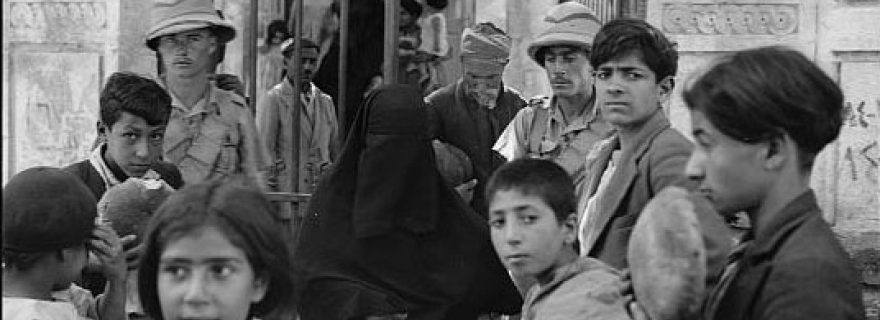Relief and Welfare in Jerusalem, 1900-1948
Christian missions in the Middle East often struggled to convert the population and changed their vocation according to local demands. Traces of such missions are found to this day, as is exemplified by the Swedish Jerusalem Society.
In 1898, the Swedish Bishop, Knut Henning G. Von Schéele, visited Jerusalem. For Von Schéele, one of the most international and well-connected members of the Swedish church elite, visiting this holiest of places was a dream come true. What seems to have made the deepest impression on the Swede, however, were not the holy sites, but the poverty, illness and need of many of the local people. Schéele´s encounters with the social realities of Ottoman Palestine roused a vision that led to action. Inspired by the Prussian Jerusalemsverein zu Berlin (established in 1841) and its work in Jerusalem, von Schéele initiated the most important (and for many years, only) Scandinavian establishment in Palestine: The Swedish Jerusalem Society (Svenska Jerusalemsföreningen or SJS).
In the Middle East, unlike in Asia and Africa, missionaries faced major obstacles in their attempt to convert locals. Conversion efforts were aimed mainly at the Jewish population, and largely failed. As a consequence, organizations like the Jerusalemsverein zu Berlin and The Swedish Jerusalem Society increasingly shifted their focus from evangelization to health and education. The SJS, which was active in Palestine in the years 1900-1948, transformed its vocation to non-proselytizing welfare work among the local population. During the years 1900-1918, the SJS ran a hospital in Bethlehem and a school for Arab girls in Jerusalem. While the hospital in Bethlehem had to close down in 1925, the Swedish School developed into one of the best run and highly esteemed educational institutions for Arab children in Mandatory Palestine. The school also provided Muslim girls from the poorer section of the city with food, medical assistance and basic education.
From 1922-1948, the school was headed by Signe Ekblad (1897-1952), a Swedish teacher whose religious calling had led her to Palestine. Linked to this calling were Ekblad´s deep ties to the Swedish Settlement movement, established in 1912, and its focus on the practice and tolerance of Jesus, social Christianity and self-help, not charity. In Sweden, as in Britain, the Settlement movement contributed significantly to the establishment of the welfare state. In Jerusalem, however, the agency of local actors and the dynamic between Arab staff and the Swedish headmistress were decisive in shaping the ideology and practice of the Swedish institution.
In the 1920s, the staff consisted of Ekblad, seven Arab teachers and one Swedish volunteer, all female. By 1940, the number of pupils had reached more than 200, with a staff of ten Arab and two Swedish female teachers. The main language of instruction was Arabic, while English was also taught. At other mission schools, most of the teaching was in English or French. With its mostly Arab teaching staff and Arabic as the main language, the Swedish school had a profound local connection and was deeply attached to the community.
The majority of the pupils came from Christian Arab middle and upper middle class homes who could afford the school fee. In addition, more than forty girls from the poorer, Muslim neighborhoods of Jerusalem attended a free course that consisted of basic Arabic, English, and sewing. In practical terms, it was a “help to self-help” project, aimed at enabling young women to support their families financially. Many of the girls were undernourished and they were given a hot meal at school. Those who needed it received treatment for trachoma (an infection of the eye). After some time, this health work included all pupils. It was recognized by the Mandate health authorities and received a relatively large sum from Jerusalem´s public administration budget.
In 1938, during the Arab uprising, the staff at the Swedish school organized a soup kitchen for the girls in the sewing class. It soon extended to offer food to the girls´ mothers and younger siblings, and finally, around one hundred children from other schools and their mothers and younger siblings also received food at the Swedish school. Ten years later, during the war of 1947-1948, the Arab staff, some of the older pupils and Ekblad again organized soup kitchens for the poor in the old city. This relief work is an example of local demands influencing the mission-project. The situation of local people and an inadequate government welfare system had direct bearing on the policy of the Swedish school´s activities.
With the new political realities after 1948, when the Swedish school became part of the state of Israel, the SJS decided to close down the school. Not until 1959 was the SJS able to return to former Palestine. This time they took over a girls´ school, The Good Shepherd´s Swedish School, in Bethlehem. The same year they also re-opened their hospital in Bethlehem. This hospital, now named Hussein bin Talal´s Hospital, is currently a regional hospital financed by the SJS and the Palestinian authorities. The Good Shepherd's Swedish School with its 300 pupils is among the most important Palestinian girls´ schools today.
The Swedish Jerusalem Society was one of many Christian missions that established schools, orphanages, health clinics and hospitals in the Middle East during the nineteenth and early twentieth centuries. These extensive welfare activities still have deep social implications for a significant part of the population in the Middle East.
Image: The raising of the siege of Jerusalem. People filing out after receiving their bread ration. From the Library of Congress, Prints and Photographs Division, Washington, D.C. 20540 USA



0 Comments